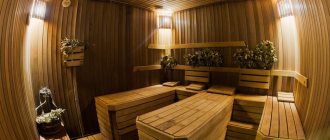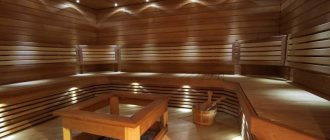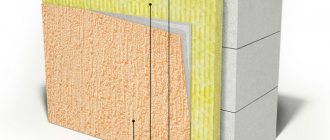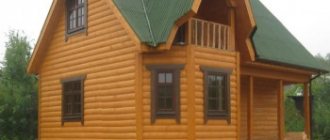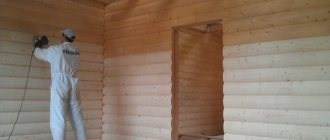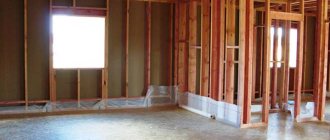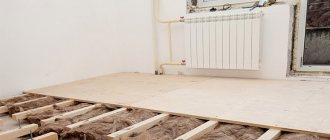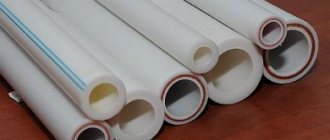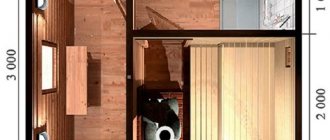Insulation is an important stage in the finishing of any private home, but in a bathhouse this operation becomes of key importance. A steam room is a room with special conditions in which extreme temperatures are combined with high humidity. No matter how well the sauna is built, if careful thermal insulation has not been done at the finishing stage, the sauna will not be able to function properly; cold will penetrate into the interior and heat will escape outside. To maintain the required temperature indicators, it is necessary to insulate it well. In this matter, you can rely on the professionalism and experience of specialists, or you can insulate the bathhouse from the inside with your own hands. The article provides step-by-step instructions for thermal insulation of a bath room.
Insulation and finishing of the steam room, what you should pay attention to
Insulating walls in a steam room will bring the desired result if you consider important factors:
- fuel consumption;
— microclimate;
- steam room arrangement.
Insulation for the walls of the bathhouse from the inside of the steam room creates a favorable microclimate.
Steam room arrangement
Many people are interested in how to properly insulate a steam room in a bathhouse. To do this, it is worth studying the device:
- wall;
- stand;
- lathing;
- isolation.
On the side, the insulation for the steam room in the bathhouse is in layers.
Steam room interior decoration
the walls in the steam room from the inside.
Options:
- plastic;
- wooden lining.
It is curious how to insulate a steam room, because users choose plastic or wooden lining. The first and second options can be classified as inexpensive materials.
Insulation
Insulation of the steam room from the inside is carried out in the following options:
- brick;
- timber;
- cotton wool.
If you are wondering how to insulate a steam room, you should take a closer look at brick. This material is suitable for large buildings. If finances allow, it makes sense to prepare timber.
Properties to insulate attention
Thermal insulation of a steam room will bring the desired result if you evaluate the following important factors:
— room temperature;
- humidity.
It is interesting to know what kind of insulation to use for a bath in a steam room. To do this, temperature and humidity are taken into account.
Floor insulation
Insulation for the steam room of a bathhouse on the floor is made according to the instructions:
- pit;
- sand cushion;
- concrete pouring.
Now it’s clear how to insulate the floor in a steam room, since it all starts with a hole where a sand cushion is formed.
Ceiling insulation
Thermal insulation for a bath in a steam room on the ceiling is represented by the following options:
— reinforced concrete slabs;
- tree.
The insulation of a steam room in a bathhouse can be made of reinforced concrete slabs. The advantage is that the option is considered sustainable.
How to properly insulate a door
Door insulation technology
Large heat losses occur through door cracks, so you must take care of the thermal insulation of the wooden or iron door leading to the bathhouse.
Felt, basalt wool, and foil insulation can be used as insulation. There are several ways to insulate a door; below we present the most common:
- A frame of 15x20 mm slats is mounted around the perimeter of the door, which should be 10 cm away from the edge of the door leaf.
- A piece of hardboard is placed inside the frame and stapled.
- Felt or other material is pulled over the top of the frame and secured with nails, which should be 5 cm larger than the frame itself.
Materials
Steam room insulation is offered in different types:
- cotton wool;
— penoplex;
- Styrofoam.
Insulating a steam room with cotton wool is an economical option. When owners want to use new materials, they choose between penoplex and polystyrene foam.
Basalt mineral wool
It is important to figure out how to insulate a steam room , and basalt wool is often suggested for this.
Advantages:
— ease of processing;
- cheapness;
— high-quality insulation.
Insulation for steam rooms in the form of basalt wool is well suited for walls.
Foil materials
In this case, we consider insulating the steam room from the inside, step-by-step instructions. Foil has the following advantages:
- environmental friendliness;
- does not burn;
- against noise.
The foil can be installed on the walls in the steam room.
View this post on Instagram
Publication from Shop “Stolyar” Blagoveshchensk (@stolyarblg)
Penoplex
I’m curious about how to insulate a steam room, and sellers insistently recommend penoplex.
Advantages:
- low moisture resistance;
- safety;
- waterproofing.
Next, the question remains of how to properly insulate the steam room. Together with penoplex, you can make insulation in one or several layers.
Styrofoam
When the question arises of how to insulate the floor in a steam room, only polystyrene foam is recommended. Experts call these advantages:
— environmental friendliness;
- low price;
— thermal insulation.
Thus, the thermal insulation of the steam room will be environmentally friendly.
Polyurethane foam
If you are wondering how to insulate a steam room with polyurethane foam, you should evaluate the advantages:
— vapor barrier;
- cheapness;
— convenient use.
For steam rooms, polyurethane foam is suitable in almost all cases.
Foil tape
Insulating the walls in a steam room with adhesive tape promises the following advantages:
- does not burn;
— withstands high loads;
- not susceptible to infrared rays.
Next, it’s interesting to figure out how to insulate a steam room. Scotch tape is considered a practical material, so large areas can be covered in a short period of time.
Wooden blocks
Wooden blocks for walls provide the following advantages:
- heat retention;
— good tolerance to high temperatures;
- waterproofing.
For the walls of the bathhouse from the inside, the supply of fresh air is important. When the surface breathes, fungus does not appear on it.
Fasteners
Plus, minus, we've sorted out how to insulate a steam room in a bathhouse. However, the question of fasteners remains.
Kinds:
- self-tapping screws;
- screws;
- dowels.
If you are wondering how to insulate a steam room in a bathhouse, you should experiment with self-tapping screws. Sometimes only dowels are useful for fixing the material.
Additional materials
Now considers the insulation of the steam room from the inside, step-by-step instructions. Additional materials are used for this:
- anchors;
— mounting angles;
- rivets.
It is important to understand how to properly insulate a steam room. You should have corners of different sizes at hand, plus don’t forget about rivets and anchors.
Extruded polystyrene foam
A modern organic-based material consisting of air capsules and foamed polystyrene. This thermal insulator is popular for use in various rooms due to the combination of its properties:
- Waterproof material. Extrusion does not absorb moisture and does not lose its insulating properties in high humidity conditions.
- Resistant to temperature changes. The material does not lose its qualities in such conditions.
- High resistance to compressive loads (which is important when insulating floors).
- Extruded polystyrene foam is a durable material. Well-known brands promise a long service life of more than 50 years with the preservation of all characteristics, which is proven by tests with repeated freezing and thawing.
- Synthetic origin makes the material unsuitable for the development of mold and fungi.
- Light weight and easy installation.
There are far fewer disadvantages than advantages, however, their presence may call into question the choice of this type of insulation as a heat insulator for a bathhouse:
- Oddly enough, it is susceptible to attacks by rodents.
- Low resistance to fire. The material does not burn, but actively melts, releasing toxic volatile substances that are hazardous to human health.
- Relatively high cost.
In a bathhouse, extrusion can be used to insulate the floor, as well as walls and ceilings in all rooms except the steam room.
Insulating a steam room from the inside step-by-step instructions
We discussed above what kind of insulation you can take and now it’s time for instructions:
— wall preparation;
— installation of sheathing;
— use of insulation;
- film.
to use thermal insulation for a bath after preparing the walls.
Materials used in arranging steam rooms
To ensure that the steam room is ready in a short period of time, the following tools are prepared:
- jigsaw;
- Bulgarian;
- hammer;
- chisel.
the wall cannot be processed; only a jigsaw will help. The bathhouse is well insulated, which means it is important to separate the material. Using a grinder, the insulation is cut into strips and then installed.
Insulation of steam room walls from the inside
In a steam room in a bathhouse for insulation from the inside, you should look at the instructions:
- insulation;
- lathing;
- insulation.
The paired material is laid as the first layer. If you use the right tool, you can prepare the sheathing. Next, all that remains is to insulate the wall. As mentioned earlier, it is allowed to use cotton wool or polystyrene foam. The bathhouse is also insulated with polystyrene foam, the main thing is to look at all the advantages and disadvantages.
Thermal protection of the floor and ceiling from the inside
Floors are prepared in a special way.
Options:
- polyethylene;
- polyurethane.
Polyethylene can be used if the floor is wooden. used into small parts for ease of installation. To install the insulating pie, sheathing is required. Lay two layers of cement screed on top.
How to line the inside correctly if the bathhouse is made of bricks or blocks
Brick buildings are the coldest, blocks made of foam concrete are still better thermally insulated, but in general both of them need additional thermal insulation, so there is no option when you simply make a sheathing on a brick wall and start installing lining on it. Because it would take a very long time to heat such a bathhouse.
Therefore, it is possible to properly sheathe the inside of a brick bathhouse with clapboard only on top of a thick (depending on the cold of your area) layer of insulation. Since mineral wool is most often used, it is worth proceeding from its popularity. Below we will give an example of the entire “pie”, with insulation and lathing for the lining in the bathhouse.
Thermal insulation of steam room walls
Options for wall insulation are considered:
— layer of expanded clay;
— brick;
- concrete.
The ceiling in the bathhouse cannot be made of expanded clay, but it is suitable for walls. The room will not be afraid of elevated temperatures. Plus, expanded clay has excellent adhesion.
View this post on Instagram
Publication from STROYCITY (@stroysiti2020)
Useful video
Of course, this is an advertisement from TechnoNIKOL, but they didn’t lie anywhere in the instructions; the pie is shown clearly and correctly:
***
Insulate yourself better and subscribe to our Telegram channel to stay up to date with all the site news!
We recommend that you read other articles that provide information on the construction and arrangement of a bathhouse:
- application and features of the production of impregnated wood;
- a list of the best antiseptics for baths and saunas;
- bath furniture;
- bath windows;
- bath painting options;
- bathhouse roofs.
What dangers await you if the steam room is not insulated correctly?
If the steam room is made incorrectly, the following dangers arise:
— accumulation of condensate;
— the wall doesn’t breathe;
- wall collapse.
If you look at the walls, cracks appear over time. With each heating, the material at these points gradually expands. The problem is that cosmetic repairs do not solve anything.
For example, a master can coat the area with paint. Even if the crack does not seem deep, the foundation may be damaged. External touch-up only delays complete destruction.
To solve the problem, you have to clean the crack from edge to edge. Next, each layer is inspected separately. If it is determined that the insulation has not been damaged, then greasing can be done. In other cases, the insulation is replaced.
Ceiling insulation
Insulation of a steam room from the ceiling is carried out according to the instructions:
— preparation of the base;
- use of cotton wool;
— installation of breathable film.
On the ceiling, it is worth removing the outer covering and going through it with a jigsaw. If you have a power tool, it is easier to process large surfaces. Craftsmen try to remove paint and damaged material.
There may be burrs left somewhere, which will affect the adhesion of the materials. If paint or other finishing material cannot be removed, you should use special primers.
In the store you can find products with quartz. It is important to check with the manufacturer for which surfaces the product is suitable. Quartz is considered to be a universal material. After priming, it is worth considering the step-by-step instructions for insulation.
For example, cotton wool and film were chosen for the steam room. This means that sheathing will have to be installed on the surface. When a square room is considered, the design is allowed to be made along guides. In this case, the planks are laid diagonally.
For installation of a guide, metal corners up to 2 cm wide are suitable. However, this option is not suitable for rooms with low ceilings. It is important to understand that the cotton wool will take another 3 cm, plus the film is laid. Next, the exterior finishing is applied.
If you use plasterboard for the ceiling, it is better to immediately choose a high-quality sealant. Some people love foam with good adhesive properties. As an option, you can consider professional cylinders.
It is quite possible to fix the sheathing on the foam, but such work looks extremely rough. Plus, it’s worth remembering that you won’t get a smooth surface. As a result, the cotton wool will not be able to adhere tightly to the surface. Once the insulation is laid, you can begin to apply the film. This is the finishing layer before finishing.
For this purpose, staples that can be fixed manually are suitable. Special guns make the job easier. Ordinary or decorative plaster is used as a finishing finish. If practicality comes first, you can simply smooth the surface.
When you want to create something beautiful, you can try decorative options with paints. Craftsmen try to first check the parameters with the manufacturer. In particular, I am interested in the maximum temperature that a fake can maintain.
Next begins the installation, where you can show the skill of using the tools. Also, do not forget about available materials. For example, you are allowed to use stencils for the ceiling. The result is an abstract drawing that will not leave anyone indifferent.
Homemade options are also appreciated when tulle is used. If you apply it to a surface, the design will quickly be imprinted on the surface.
Technical characteristics of insulation for a wooden bath
Of all available insulation materials, it is necessary to choose moisture- and vapor-proof materials
A bathhouse is a place with constant contrasting temperature changes and high humidity. Under such conditions, finishing materials and structural elements made of synthetics heat up intensely and emit harmful substances. Contact with them can cause burns.
To ensure that the bathhouse becomes a place for improving health rather than losing it, materials are selected for specific operating conditions. The domestic product market offers a wide selection for thermal insulation of steam rooms. It must have the following characteristics:
- low thermal conductivity;
- resistance to wet environments;
- heat resistance;
- naturalness of materials;
- environmental friendliness.
When exposed to steam and moisture, mold appears on the walls - they need to be insulated
The log house is assembled from cedar, pine, and larch. The cladding is carried out with lining made of pine, aspen, cedar, linden. Insulation for a bath should prevent the formation of mold, retain its original shape, and have a low moisture absorption rate. At the same time, do not have a harmful effect on other structural elements. The bathhouse is built to last for decades, so the insulation must last its entire service life.
Water-repellent properties are important for use in the washing department, steam room, sauna.
Thermal insulation of external walls is carried out if the thickness of the timber is insufficient to effectively retain heat:
- perform the sheathing using timber or metal guides in the vertical and horizontal direction;
- install thermal protection from expanded polystyrene or mineral wool;
- arrange moisture and wind protection;
- install a counter-lattice for ventilation of the facade - a distance of at least 2-3 cm should remain between the protective film and the finishing;
- perform finishing work.
Such insulation will significantly reduce heat loss and is suitable for designing baths made of bricks and blocks. Also, thanks to the additional layer, the building is protected from precipitation and ultraviolet radiation, which significantly extends its service life.
Insulation and foil covering of a steam room
for holding steam , but instructions are required:
- measurements of the room;
— installation of reinforcing mesh;
- use of foil.
In the case of foil, the upper part of the wall should be re-primed. The sheathing can be done in several ways. In the first case, the boards are laid crosswise. The nails are prepared and should be nailed with an indentation of 6 cm.
This creates a durable frame that can be fixed to the wall. It is attached not only on the sides, but also in the center. The master should pay attention to the gaps.
For example, there is a wall 5 by 2 meters. Some edges will come away because the sheathing is not able to fit tightly everywhere. In some places it is due to the poor quality of the material, in others the strength of the fasteners is not enough.
In any case, such places are fixed separately to the wall. Next, all that remains is to deal with the foil. The craftsman must spread out the material and then apply glue. After this, all that remains is to leave a layer of primer again.
Foil will work well if it is installed with a margin in the corners. Common mistakes relate to rough installation. For example, during quick installation, the foil is undermined in the center or at the edge. Then you won’t be able to just tape the place.
The insulation after a break can be considered spoiled; you will have to start all over again. If the foil is placed on the ceiling, you can purchase drywall. The secret is that the ceiling option is selected. Without lathing, the material is pressed with sheets.
In this case, you can use guides. Metal corners are installed along the edge of the wall. For this, small dowels are used. Do not forget that ceiling sheets are used with a thickness of up to 2 cm.
The advantage is that they are used in a small mass. If you wish, you can do the work yourself, but they require support. For everything to work out, it is important to prepare enough glue.
The surface will have to be treated twice. First, the master removes the old coating and simply cleans the surface of debris. Then the first layer of glue is applied. Some people use sealant, but a lot depends on the surface.
If the bathhouse has a wooden floor that has not been damaged by time, you can immediately proceed to glue. When darkening is visible, the material has lost its properties; you cannot do without a primer.
Next, the foil is laid and pressed with a plate. The quality of work can be easily checked by simply tapping the surface. Once the drywall is coming off, there is no need to do any finishing work.
Peculiarities
In the good old days, bathhouses were built from round wood and were not finished with insulating materials. An indicator of warmth was carefully selected wood, high-quality timber and tightly caulked grooves between the crowns. At that time, replacement of insulation was carried out using moss, tow or jute and caulking in two stages - when cutting the log house and after its shrinkage.
Many people today prefer natural insulation, although drying is required before using it, but it is an environmentally friendly material. This insulation process is very labor-intensive and time-consuming, requiring a certain skill and dexterity. Poorly caulked seams will allow heat to pass through and moisture will begin to accumulate in the grooves, which will contribute to the rotting of the wood and the rapid release of heat from the steam room.
Modern technologies have made it possible to find more than one alternative method of insulation.
Thanks to thermal insulation, well-insulated baths have a number of undeniable advantages:
- such a bath takes longer to warm up, but also takes a long time to cool down;
- has the lowest heat consumption;
- it achieves the desired microclimate;
- there is humidity control;
- protected from the appearance of fungus and mold.
And in order to achieve such results from a bathhouse, you must first of all approach this process competently, although, at first glance, there is nothing complicated about it. For greater efficiency, the bathhouse is insulated both inside and outside. External placement of thermal insulation helps protect the material from which the bathhouse is made. But external insulation alone will not be enough. In different rooms of the bathhouse it is necessary to maintain a certain temperature and humidity level. For this purpose, internal insulation is provided, and suitable material is selected for each individual room.
Insulation of the ceiling and floor in the steam room from the inside
An insulated steam room must be protected from below and from above.
Instructions for operation:
- Preparation;
- adhesive layer;
— insulation;
— surface primer;
- plaster.
To work on the floor, you will have to remove the outer covering. For example, it is worth considering wooden lining. When using a crowbar, it is important to pry off the material. After this you can look at the base. If only bare bars are laid, it is even simpler and does not require removing anything.
When old insulation is used, it is no longer suitable. Don't think that you can put new material on top and everything will be fine. The secret is that the insulation must cover the entire surface from edge to edge.
When old materials are used, they sag and pull the next layers with them. Even if you build a sheathing, there is no point in taking up so much space with several layers.
If cotton wool is selected, stripping is done and then the mesh is prepared. At this stage of work, it is worth checking that the edges are even. The mesh can be secured to the surface with staples. If a concrete surface is used, dowels are selected.
The advantage of the mesh lies in the fact that the cotton wool will last much longer. The advantage for the builder is the moderate use of material. When cotton wool is simply placed in free cells, there will be more of it in some places, less in others.
This option always has a negative effect on insulation. In places where there is the least amount of cotton wool, wet spots appear. Over time, they will spoil the base material. As soon as the temperature changes sharply, irreversible consequences occur. They work the same for both wood and concrete.
